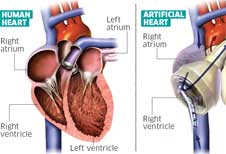Home for the holidays, the patient with a plastic heart
The device is connected by leads running through the skin to a portable power pack that weighs 13lb

The first man in Britain to receive a complete plastic heart and walk out of hospital said yesterday his life has been transformed by the operation.
Click HERE to view graphic (92k jpg)
Matthew Green, a 40-year-old father from north London, would almost certainly not have survived without the artificial organ that surgeons at Papworth Hospital in Cambridge transplanted into his chest cavity after removing most of his heart.
Mr Green, who underwent the six-hour operation on 9 June, said his new artificial heart – powered by a portable "driver" backpack – will transform his prospects, which had been damaged by debilitating ill health since he developed serious heart disease.
"It's going to transform my life," he said. "Before, I couldn't walk anywhere. I could hardly climb a flight of stairs and now I've been walking out and getting back to normal life.
"I went out for a pub lunch over the weekend and that just felt fantastic, to be with normal people again. Two years ago I was cycling nine miles to work and back every day but by the time I was admitted to hospital I was struggling to walk even a few yards.
"I am really excited about going home and just being able to do everyday things that I haven't been able to do for such a long time, such as playing in the garden with my son and cooking a meal for my family."
Artificial heart transplants in the past have usually been partial operations, in which the mechanical device is placed alongside the patient's own heart in order to rest it and allow it to recover.
However, Mr Green suffered from arrhythmogenic right ventricular cardiomyopathy, in which the two large chambers of the heart – the ventricles – were so diseased that they had to be removed completely.
The total artificial heart, made by the American company SynCardia, weighs 5.6oz and consists of two plastic chambers that pump blood separately around the lungs and the body, just like the right and left ventricles of a normal heart.
The internal device is connected by leads running through the skin to a portable 13.5lb power pack.
Artificial hearts carry the risk of blood clotting and infections, but the aim is to give Mr Green time so that a permanent replacement heart can be found from a suitable donor, said Mr Steven Tsui, the consultant cardiothoracic surgeon at Papworth who led the operating team.
"At any point in time there may be as many as 30 people waiting for a heart transplant on our waiting list, with one third waiting over a year," Mr Tsui said. "Matthew's condition was deteriorating rapidly and we discussed with him the possibility of receiving this device, because without it he may not have survived the wait until a suitable donor heart could be found for him.
"The operation went extremely well and Matthew has made an excellent recovery. I expect him to go home very soon, being able to do a lot more than before the operation with a vastly improved quality of life, until we can find a suitable donor heart for him to have a heart transplant."
Papworth is the only UK centre currently certified to implant SynCardia's total artificial heart.
Unlike a left ventricular assist device, which only helps the failing left ventricle, the total artificial heart pumps blood around the lungs as well as the body.
Transplant milestones
1964 US National Institutes of Health starts artificial heart programme.
1966 First transplant of partial mechanical heart, to assist pumping of ventricle.
1969 Texas man receives first total artificial heart transplant. After 64 hours on the mechanical device received a donor organ, but died within two days.
1982 Artificial heart designed by Utah University doctor Robert Jarvik implanted into man who survived for 112 days.
2001 First surgical implant of internally powered artificial heart, which was charged via transduction through skin.
Subscribe to Independent Premium to bookmark this article
Want to bookmark your favourite articles and stories to read or reference later? Start your Independent Premium subscription today.

Join our commenting forum
Join thought-provoking conversations, follow other Independent readers and see their replies